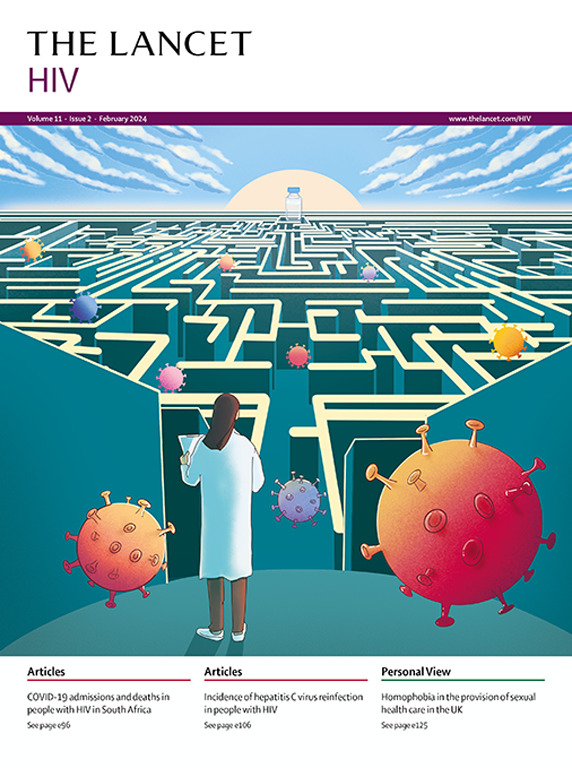在接受抗逆转录病毒治疗的儿童和青少年中,按年龄、治疗时间和地区划分的艾滋病毒相关死亡率趋势:一项系统回顾和荟萃回归分析
IF 13
1区 医学
Q1 IMMUNOLOGY
引用次数: 0
摘要
背景:过去的队列研究调查了接受抗逆转录病毒治疗(ART)的儿童和青少年(0-14岁)的死亡率,但没有进行系统评价来综合这些发现。我们的研究旨在对接受抗逆转录病毒治疗的儿童和青少年的儿科死亡率提供最全面的全球估计。方法:为了进行系统评价和meta回归分析,我们检索了PubMed和Embase从1990年1月1日至2024年7月31日期间报告接受抗逆转录病毒治疗的艾滋病毒感染儿童和青少年死亡率的研究。我们采用为2019年全球疾病负担研究开发的贝叶斯先验、正则化和修剪工具进行meta回归分析,按地区、CD4细胞计数或百分比、年龄、性别和治疗持续时间估计抗逆转录病毒治疗后的死亡率。我们通过进行敏感性分析来评估结果的稳健性,使用纽卡斯尔-渥太华量表和国家心肺血液研究所的质量评估工具,将其限制在高质量的研究中。本研究已在普洛斯彼罗注册(CRD42022382702)。我们检索到7588条文献,其中5853条被确定为与标题和摘要综述相关。筛选后,选取1068条记录进行全文评估。我们在系统综述中纳入了84项研究,其中66项纳入了meta回归分析。我们的分析表明,在对地区、基线CD4细胞计数、年龄、治疗持续时间和性别进行调整后,全球所有儿童和青少年(0-14岁)的艾滋病毒相关死亡率在2000年至2020年间随着时间的推移而下降。此外,艾滋病毒相关死亡率随着抗逆转录病毒治疗开始时CD4细胞计数的增加和治疗时间的延长而下降。在死亡风险方面存在着相当大的地域差异。在2020年高死亡率组(抗逆转录病毒治疗持续时间<6个月,年龄<1岁,男性,CD4细胞计数最低)中,各区域艾滋病毒相关死亡率从撒哈拉以南非洲东部每100人年11.7例死亡(95% CI为8.3 - 15.4)到亚太地区每100人年77.2例死亡(95% CI为47.1 - 98.1)不等。在2020年低死亡率组(抗逆转录病毒治疗持续时间≥1年,年龄5-9岁,女性,CD4细胞计数最高)中,艾滋病毒相关死亡率从撒哈拉以南非洲东部的0.09例死亡(0.007 - 0.10)/ 100人年到拉丁美洲和加勒比地区的0.020例死亡(0.003 - 0.080)/ 100人年不等。综合的儿科艾滋病毒护理方法对于改善感染艾滋病毒的儿童和青少年的预后至关重要。在临床上,这种方法包括加强对垂直传播的预防,确保婴儿早期诊断,并及时开始治疗——理想情况下,CD4细胞计数较高。从政策角度来看,卫生系统需要解决不同区域、年龄组和性别之间在治疗可及性和结果方面的差异。努力还应优先考虑尽量减少治疗辍学和扩大获得高质量艾滋病毒服务的机会。这些战略可以共同支持减少儿科艾滋病毒负担的全球目标。美国国家过敏和传染病研究所以及美国国家卫生研究院。本文章由计算机程序翻译,如有差异,请以英文原文为准。
HIV-related mortality time trends among children and young adolescents on antiretroviral therapy by age, treatment duration, and region: a systematic review and meta-regression analysis.
BACKGROUND
Past cohort studies have examined mortality among children and young adolescents (aged 0-14 years) who have received antiretroviral therapy (ART), but no systematic reviews have been undertaken to synthesise these findings. Our study aims to provide the most comprehensive global estimates of paediatric mortality among children and adolescents receiving ART.
METHODS
For this systematic review and meta-regression analysis, we searched PubMed and Embase from Jan 1, 1990 to July 31, 2024 for studies reporting mortality among children and young adolescents living with HIV who were on ART. We employed the meta-regression with Bayesian priors, regularisation, and trimming tool, developed for the Global Burden of Disease study 2019, for meta-regression analysis to estimate on-ART mortality by region, CD4 cell count or percentage, age, sex, and treatment duration. We assessed the robustness of our results by doing a sensitivity analysis, restricting it to studies of good quality using the quality assessment tool adapted from the Newcastle-Ottawa Scale and the National Heart, Lung, and Blood Institute. This study has been registered with PROSPERO (CRD42022382702).
FINDINGS
Our literature search identified 7588 records, of which 5853 were determined relevant for title and abstract review. Following screening, 1068 records were selected for full-text assessment. We included 84 studies in our systematic review, of which 66 were included in the meta-regression analysis. Our analysis indicated that HIV-related mortality for all children and young adolescents (aged 0-14 years) decreased over time, between 2000 and 2020 globally, after adjusting for region, baseline CD4 cell count, age, treatment duration, and sex. Additionally, HIV-related mortality decreased with increasing CD4 cell count at ART initiation and longer treatment duration. There have been considerable geographical variations in the risk of mortality. Among the high-mortality group in 2020 (ART duration <6 months, age <1 year, male, and the lowest CD4 cell counts), HIV-related mortality across regions ranged from 11·7 deaths (95% CI 8·3-15·4) per 100 person-years in eastern Sub-Saharan Africa to 72·0 deaths (47·1-98·1) per 100 person-years in Asia-Pacific. Among the low-mortality group in 2020 (ART duration ≥1 year, age 5-9 years, female, and the highest CD4 cell counts), HIV-related mortality ranged from 0·09 deaths (0·07-0·10) per 100 person-years in eastern Sub-Saharan Africa to 0·20 deaths (0·03-0·80) per 100 person-years in Latin America and the Caribbean.
INTERPRETATION
A comprehensive approach to paediatric HIV care is essential to improving outcomes for children and young adolescents living with HIV. Clinically, this approach includes strengthening the prevention of vertical transmission, ensuring early diagnosis in infants, and initiating treatment promptly-ideally at higher CD4 cell counts. From a policy perspective, health systems need to address disparities in treatment access and outcomes across regions, age groups, and sex. Efforts should also prioritise minimising treatment dropout and expanding access to high-quality HIV services. These strategies could collectively support global goals to reduce the burden of paediatric HIV.
FUNDING
The National Institute of Allergy and Infectious Diseases and the National Institutes of Health.
求助全文
通过发布文献求助,成功后即可免费获取论文全文。
去求助
来源期刊

Lancet Hiv
IMMUNOLOGYINFECTIOUS DISEASES&-INFECTIOUS DISEASES
CiteScore
19.90
自引率
4.30%
发文量
368
期刊介绍:
The Lancet HIV is an internationally trusted source of clinical, public health, and global health knowledge with an Impact Factor of 16.1. It is dedicated to publishing original research, evidence-based reviews, and insightful features that advocate for change in or illuminates HIV clinical practice. The journal aims to provide a holistic view of the pandemic, covering clinical, epidemiological, and operational disciplines. It publishes content on innovative treatments and the biological research behind them, novel methods of service delivery, and new approaches to confronting HIV/AIDS worldwide. The Lancet HIV publishes various types of content including articles, reviews, comments, correspondences, and viewpoints. It also publishes series that aim to shape and drive positive change in clinical practice and health policy in areas of need in HIV. The journal is indexed by several abstracting and indexing services, including Crossref, Embase, Essential Science Indicators, MEDLINE, PubMed, SCIE and Scopus.
 求助内容:
求助内容: 应助结果提醒方式:
应助结果提醒方式:


